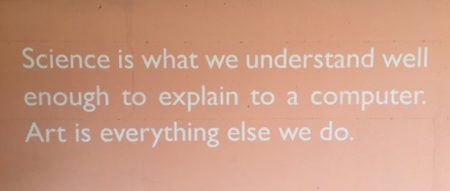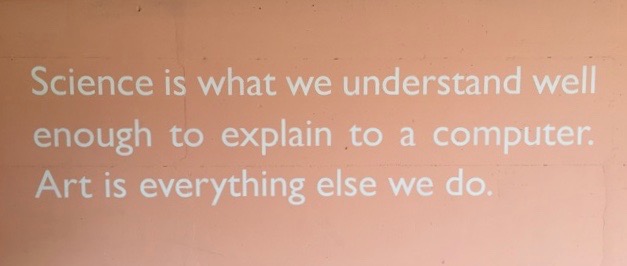
I saw this slogan on a wall at EPFL in Lausanne recent, and it got me thinking. “We have a science based target” is the only phrase that needed to be uttered in climate circles for the last few years. Everyone nods in agreement. You are one of us. So its no surprise that the “Science Based…” bandwagon is moving onto biodiversity, water, land and more.
I have written before about complex issues and the notion of quantum sustainability. Yet before we jump headlong into science based targets (SBTs) we need to realise the unintended consequences of trying to navigate this complexity and uncertainty with a simple tool. It may well divert attention from the real issues that we need to be working on to tackle the climate emergency.
Science or Art?
The concern about SBTs is the artistry that goes into the whole process. There is a flexibility to choose the baseline year, the climate scenario and which parts of the business to include. This leads to a lack of comparability across companies. Then there is the question of Scope 3 emissions.
A few years ago, a colleague pointed out that science based targets for scope 3 emissions are “pure speculation”. The point being that you can’t have science based targets where there is no science. It’s a good line, and essentially true. Calculating scope 3 emissions is a fraught process that relies upon a range of methodological estimates, assumptions and dodgy data.
1.5 Degrees to the Rescue?
Thank heavens therefore for the IPCC 1.5 degrees report. This states that to limit global heating to 1.5 degrees we need to halve GHG emissions in the next decade. This has just simplified the whole SBT process and saved companies a whole lot of consultancy fees.
However, a new angle in the climate discourse has come onto the scene. The TCFD (Task Force on Climate Related Financial Disclosures) introduces a new type of science and artistry into the climate debate. Companies reporting to TCFD have to show their resilience under different scenarios.
This is where things get really interesting for some industry sectors. In thinking through the scenarios it turns out that transition risks become arguably as significant as the physical risks that we are used to talking about. And more immediate, as business decisions and responses are needed now. Which got me reading up about game theory.
SBTs bump up against Game Theory
Game theory can help us work out likely strategies and actions to address climate change (and even other sustainability challenges such as plastics). However, applying game theory to climate change produces some sobering results. As an article in Wired magazine highlighted, climate change is likely to get a lot worse before it gets better.
SBTs might even make the situation more painful for those companies that have signed up to them, in good faith. There are currently close to 600 companies signed up to the SBT initiative. That leaves tens of thousands who have not. Despite those 600 managing their operations to achieve a 2 degrees of heating, we are still heading for 4-5 degrees. Which means that the next round of SBTs have to get stricter. Game theory suggests that this cycle will repeat itself. Potentially repeatedly.
Yet with the easy stuff now done, signatories to SBTs will soon be required to implement disruptive business models and make significant investments that will pay off if the climate stabilises. But if the majority maintain their business as usual approach the climate will still head for 4-5 degrees of heating. Those investments will then be completely lost, and those companies will need to invest all over again to adapt to an outcome they tried to avoid. Investors will not be so forgiving regarding these transition risks. Which suggests its time to focus more upon context.
Context Based Targets
Context Based Targets reflect systems thinking, taking into account not just thresholds, but allocations, and adjustments for changes in the world. A few years ago Mark McElroy wrote a good description of the difference between science and context based targets. I would go further and suggest that the context needs to include the actions of competitors, government and society (especially investors and consumers).
Which starts to explain the commitment recently made by the UK Government. It committed to “net zero emissions” by 2050, but said that it would revisit this commitment (and its consequent actions) every 5 years. Given the current unknowns regarding the actions of other Governments, under a game theory this looks entirely logical*.
The New Climate Leadership
The difference between “business as usual” and “1.5 degrees” scenarios is now dramatic. Once companies understand the actions needed to halve all value chain emissions, transition risks will become the primary consideration for many. This means getting a handle on the actions of others, and the consequences of “free riders”. Getting too far ahead of mainstream society will need to be weighed up against the bragging rights of being “a climate leader”.
This is not a fatalistic justification for inaction. It is clear though that legislation will be the only way forward, and so corporate leadership will be demonstrated as much through advocacy as from actions. And context based targets, with their rationale clearly communicated will say more than SBTs can.
As for the end game, Extinction Rebellion look to have nailed it.
*I do accept that the commitment is pretty hollow when put against the actions of the UK Government that recently approved a new coal mine and continues to push for a new runway at London’s main airport. But that just emphasises the context that companies need to factor in.

